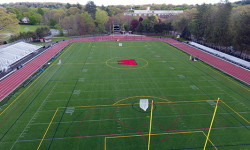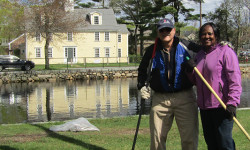By Lisa Moore
Hometown Weekly Correspondent
The Wellesley Natural Resources Commission (NRC) recently held a community forum on pond health as part of its “Grow Green Wellesley” initiative. The forum, titled “Saving our Ponds: What Wellesley is doing and how can you help,” was held in the Kingsbury Room at Wellesley Police Station. The room was filled to capacity with residents concerned about the health of the local ponds.
Director of Projects for the Charles River Watershed Association Julie Dyer Wood began the forum with a discussion of how the changes we make to the land impact how water interacts with the land. She explained that in undeveloped land, when precipitation falls, approximately 10 percent of the water will run off, collecting in streams, ponds, rivers, and oceans. It takes with it any possible pollutants it carries from the land, such as gas, pesticides, fertilizers, animal waste, and garbage. The remaining water seeps into the land and filters into the groundwater, is absorbed by plant roots, or evaporates.
In developed land, however, runoff makes up 55 percent of water movement, with a much lower percentage of the water being filtered through soil and plant roots, and a higher volume of pollutants being carried directly into oceans, streams, rivers, and ponds. The result of the higher rates of runoff can cause nutrient pollution. For example, fertilizers, which are high in the nutrient phosphorus, can be responsible for sending two times the amount of phosphorus than found in a healthy river into the water. This excess nutrient causes an imbalance in the water, allowing for overgrowth of aquatic plants. This can create hazardous algae blooms, such as a cyanobacterial bloom, which produce toxins that concern public health. In addition, the excess nutrients can increase the growth of aquatic plants and invasive species like the local scourge of town ponds, water chestnut. These overgrowths can decrease water quality, impact native flora and fauna, and change water flow patterns, leaving some locations with too little or too much water. Storm water runoff is the number one contributing factor to polluting local ponds, rivers, and streams.
How each municipality deals with the management of wastewater, drinking water, and well water can vary greatly. The methods of water management used are often designed to meet public health needs without integrating or considering the natural systems that are effected. This type of management is called the “silo approach,” and often leads to export or import conditions.
 In an effort to address runoff concerns, many cities are attempting to create “blue cities” by recreating the natural water cycle. This includes installing green storm water infrastructure areas where plants are used to intercept storm water runoff, filtering the water through their roots and soil before entering the groundwater and eventually making its way to the rivers, streams, and ponds. Planters, permeable pavement, rain gardens, rain barrels, and cisterns are a few examples of ways to address storm water runoff. Since Wellesley is part of the Charles River Watershed, a 308 square mile watershed in one of the most densely populated parts of Massachusetts, activities upstream of Wellesley impact the local water supply.
In an effort to address runoff concerns, many cities are attempting to create “blue cities” by recreating the natural water cycle. This includes installing green storm water infrastructure areas where plants are used to intercept storm water runoff, filtering the water through their roots and soil before entering the groundwater and eventually making its way to the rivers, streams, and ponds. Planters, permeable pavement, rain gardens, rain barrels, and cisterns are a few examples of ways to address storm water runoff. Since Wellesley is part of the Charles River Watershed, a 308 square mile watershed in one of the most densely populated parts of Massachusetts, activities upstream of Wellesley impact the local water supply.
Wellesley has a 5,000-acre watershed that deposits into a 105 acre pond, Morses Pond. Morses Pond and the wells that surround it supply 40 percent of the town's drinking water. In an effort to keep Morses Pond and the drinking water it supplies to the town clean, the town has several tactics it employs. Morses Pond Manager of Water Resources Services Ken Wagner spoke about the town's use of bio filtration tactics, like installing rain gardens around the pond, leaving a 25 foot buffer zone of grassy areas around the perimeter of ponds and streams to act as filters for runoff, not building in wetlands, and decreasing impervious cover around areas where storm runoff enters rivers and streams. In addition, Wellesley has introduced polyaluminium chloride into the two main tributaries that feed into Morses Pond. This substance is the same substance used in water treatment plants. The aluminum, a naturally occurring element in soil, binds with phosphorous, effectively inactivating the phosphorous. In essence, the town is performing a water treatment act in the natural environment.
Maintaining the health of the nine ponds and the many tributaries that dot and crisscross the town requires every resident’s participation. Whether or not a person’s home directly abuts a pond, river, stream, or wetland is irrelevant to the need for every resident to do his or her part. Small acts make a difference. When a careless dog walker neglects to clean up after Fido and rain washes the waste into the runoff, it enters the water supply, increasing the e-coli bacteria in the water. Imagine what the drinking water quality would be like if every dog-owning resident left their dog waste in the street.
Additionally those who practice careless lawn maintenance have a direct negative impact on the local drinking water. Using pesticides, over-fertilizing, cutting vegetation in the 25-foot buffer zone, depositing yard waste in wetlands and along wooded swaths of land - all have a negative impact on the local water supply.
In addition to the pollutants that runoff brings into the water supply, sediments from soil, stripped of plants and their anchoring roots, runs off into the water. This siltation, in effect, starts to fill in the lake, pond, or stream. However, nature will find a way and the water must go somewhere, flooding previously dry areas and drying previously wet ones. This can lead to habitat destruction and flooding in homes and businesses as water is diverted by silt formation. With the town using aggressive maintenance tactics - including harvesting and removal of invasive water plants, chemically treating the water with polyaluminium chloride, and dredging silt laden ponds to restore natural depths - along with every individual doing their part to use green practices, the town water supply, and thus its ponds, streams, and tributaries, will be healthy, adding to the health of the various flora and fauna that depend on the watershed for their survival, including human residents.
President of Friends of Morses Pond and Chair of the Wellesley Wetlands Protection Committee Richard Howell gave some tips to residents on what they can do to help maintain the health of Wellesley ponds. “Wellesley ponds need your support," he said. He suggested pulling out invasive weeds, recreating 25 foot buffer zones around property that abuts wetlands, using practices that decrease runoff, addressing areas of compacted soil, redirecting runoff onto lawns or rain gardens to filter it, decreasing use of chemicals and pesticides in yard maintenance, practicing storm drain awareness, and advising abutters of the ponds in town that they should actively be involved in the pond maintenance, forming committees that support the efforts at pond maintenance.
For more information about how to help maintain healthy ponds in town, visit www.wellesleyma.gov and click on the NRC tab.






















